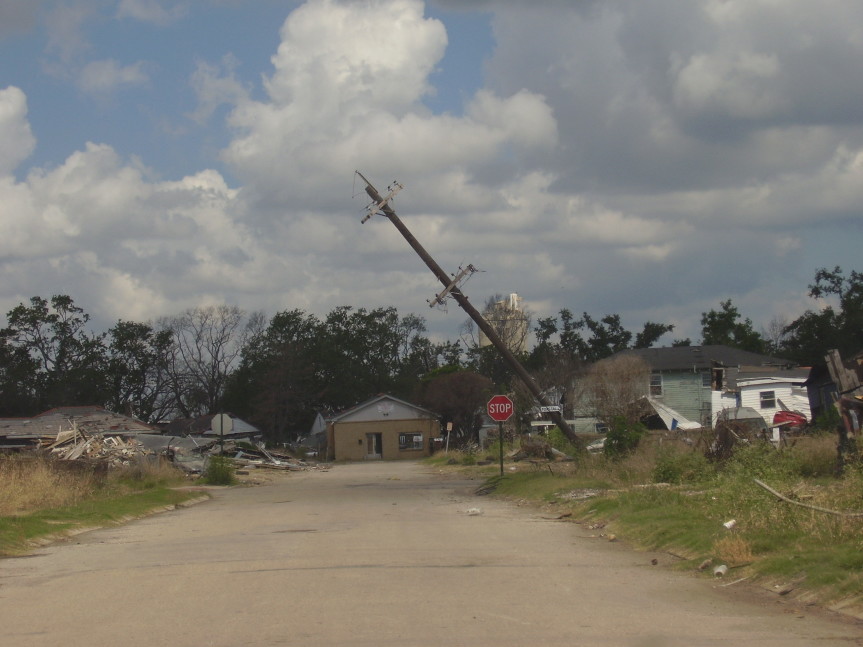10 years ago, I drove into a darkened New Orleans. Literally. The streetlights were off, traffic lights non- functional, and there were still large swaths of the city with no power. It’s hard to explain what it was like. Driving down the I-10, and seeing the increasing devastation in the countryside, as you approach, and as the sun dips, you get off the exit into the City, and it’s dark. Car headlights forming miner’s flashlights cutting beams through the unknown, jigsawing their way through the darkness, slowly revealing, in glimpses, the aftermath of devastation.
I have a great sense of direction, but in New Orleans I was always lost. It wasn’t just the pre-GPS days, the often absent street signs, those twisted sideways by the storm, or even New Orleans’ bowl shaped layout, there was just something disorienting. As someone who works with schools, there is a certain rhythm to weekdays that almost goes unnoticed, kids and buses lining the streets in the morning, and students in school uniforms spilling out in the streets mid-afternoon. None of that was happening, kids were just kind of hanging out when you saw them, and schools were shuttered.
10 years later, despite some very real and important gains, on my recent visit back, I heard continuing dissent from many of my compatriots around whether things were “really” better for everyone. New Orleans has the third highest rate in the US of youth aged 16-24 who are not in school nor employed. In some schools, “no excuses” discipline with its gratuitous suspensions and expulsions and all too often student shaming had eclipsed more humane and responsive approaches to children and families. And sometimes, the staff, being unreflective of the community, and seeming condescending in relating to it, had reinforced fears that New Orleanians had about outsiders coming in post-storm and the ability of folks to really understand and meet student needs.
Let me say that New Orleans kind of kicked my ass in the first round, not the schools, community, or kids, but moreso the politics and honestly many of those in the so-called reform movement. The New Orleanians were inspirational, finding bootstraps in the mud, literally digging sludge from server rooms and opening doors to kids on the street who needed some sense of stability, as I described in a prior article here. At the same time there was a deep and enduring undercurrent of separation and racism, New Orleans was alone in having selective admissions charter schools, and even those schools that were not technically selective often had a confusing range of preferences that tended towards certain families. And believe me, folks in the community knew that the system was rigged.
There was also an influx of ed reformers, or “deformers” as we/they are often called, who saw opportunity in NOLA. Some saw opportunity for the abysmal system to improve, others for themselves, and some you couldn’t tell. But I could tell that they often didn’t really get “it”, and as the only brother in the room or one of two, most of the time, in a system where the vast majority of kids are Black, folks seemed a bit out of touch. And worse, they either didn’t see the racial impacts of some of the reforms, or some times when those concerns were voiced, they did their best to avoid them. Race and education are embedded in America, and if you don’t see that in a place like New Orleans, you will not get reforms right.
Things have improved in terms of student achievement for students in the schools based on relatively valid indicators. ACT scores, high school graduation, and college acceptance rates, have all grown at rates that significantly outpace the State, and according to fairly comprehensive research study by the Education Research Alliance of New Orleans, found here , there is a very strong effect size of the reforms themselves. This is all very encouraging, and despite the grumblings, many of the grumblers also admitted that the prior system was terrible, and that this very imperfect and still skewed system is probably better than what was.
But Better is not good, and New Orleans is not nearly good enough in terms of having sufficient quality options for families. While the number of A and B rated schools has increased there still are far too few quality schools to meet demand. School choice feels like a fraud when you can’t get into quality options, so we have to continue to work on the supply side of quality.
These are lessons for any city that is looking to move forward with similar sets of reforms; increasing school choice, creating common enrollment, and more rigorous enforcement of accountability upon low performing schools. We have to learn by looking back honestly and dreaming forward ambitiously. This means not just putting up street signs and opening roads, but being sure that everyone accesses those paths equally, and that some predictable historical victims are not left by the wayside.





